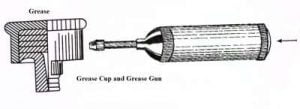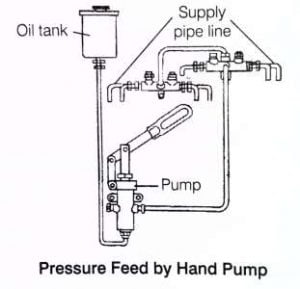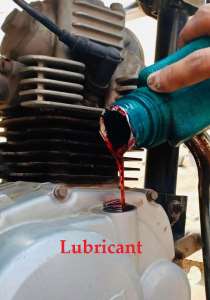Table of Contents
Lubricant
- In the Roman era, lubricants had been based on oil and rapeseed oil, as well as animal fats.
- It is the life – blood of the machine, keeping the vital parts in perfect condition and prolonging the life of machine.
- It saves the machine and its parts from corrosion, wear and tear and it minimizes friction.
Definition of Lubricant
- A lubricant is a substance having an oily property available in the form of fluid, semi – fluid or solid state.
or
- A lubricant is substance introduced between two mating parts to reduce friction.

Image: Lubricant
Purposes of Lubricant
- It improves the machine efficiency.
- It prevents corrosion, wear and tear.
- This reduces friction.
- It cools the moving elements.
- It aids in distributing the load.
Properties of Lubricant
The properties of lubricants are as follows:
1. Oiliness
2. Viscosity
3. Flash Point
4. Fire Point
5. Pour Point
6. Emulsification
7. Acidity
8. Oxidation
9. Votarility
10. Specific Gravity
11. Carbon Residue Contents
1. Oiliness
- The oiliness term relates to a lubricant tendency to wet and adhere to a surface in which thin layer of oil film is formed in between two moving parts. So, surface remains oily.
2. Viscosity
- The viscosity is a measurement of the internal resistance of a lubricant i.e., heavy oil has high viscosity and light oil has low viscosity.
- It’s indicate the viscosity of lubricant by numbers such as SAF -30, SAF -40 etc.
3. Flash Point
- The flash point is the temperature at which , a lubricant converts into steam.
4. Fire Point
- It is a temperature point at which oil or lubricant tends to the vapourising i.e., 15 to 25° C. Each oil or lubricants have a separate fire and flash point.
- It should be less than the working temperature of bearing.
5. Pour Point
- The pour point of a lubricants are the lowest temperature at which, an oil will flow from its container.
- At low temperature, the viscosity of the oil forms wax crystals. These crystals can clog filters and small openings.
6. Emulsification
- The emulsify means combining two liquids together which normally do not mix. So, when oil comes contact with water, this is term as emulsification, e.g., steam engine, steam turbine, hydraulic turbine, etc.
7. Acidity
- In greases, causticity indicates the nearness of corrosive sort constituents whose focus is typically characterize as far as all out corrosive number.
- The acidity should not be present in oil.
8. Oxidation
- The oxidation reduce the flow of oil when lubricant contact with hot air. This oxide formation is stop by adding in the oil.
9. Votarility
- It is a lubricant property that defines its evaporative loss characteristics. In this process, less emulsification of an oil else consumption is more.
- It is the most important in high temperature applications where low viscosity oils are utilize, such as engines. Also, the most volatile a lubricant, the greater its flammability.
10. Specific Gravity
- It is a property of an oil at which its weight compared with water at 30° F.
11. Carbon Residue Contents
- Carbon residue contents of any oil indicated, its capacity of lubricating and quantity of reduced contents. A good lubricant has negligible carbon residue contents.
- For an engine in combustion and com-pressure process, its quantity should be negligible.
Types of Lubricant
Normally, lubricants are classified into three groups such as
1. Liquid Lubricants
a. Mineral oil
b. Organic oil
c. Synthetic oil
d. Blended oil
2. Solid Lubricants
3. Semi – solid Lubricants
1. Liquid Lubricants
- It is available in liquid form such as mobile oil, spindle oil, natural oils, mineral oils, semi solid lubricants, liquid lubricants.
There are four types of liquid lubricants as follows.
a. Mineral oil
- It is a substance which comes from petroleum. These oils contain the paraffine and naphthanic quantity, i.e., stable with the high temperature.
- E.g., Circulating oil, gear oil, machine or engine oil, refrigeration grade oil, steam cylinder oil and wire rope oil.
b. Organic oil
- It is a substance which comes from the animals, vegetables and fishes. It is conducted the alcohols and fat acids.
- Due to these components, it has an oxide property in the coagulation at the low temperature for the coagulation at the low temperature.
- For the heavy load, it is mixed with the mineral oil. It is also term as the compound oil.
c. Synthetic oil
- It is substance comes from the polakaline glycols, silicons and silicon carbide.
- In the refinery, silicon carbide converts into silicon and oxygen and mixed with another elements / metals, got the silicon lubricant.
- These oils having continuous long life its qualities. So that, it is used to the precision tools.
d. Blended oil
- To make the heavy lubricant and increasing the viscosity, the fatty oil 5 to 20 % is used. It is called compound oil or blended oil.
2. Solid Lubricants
- Solid lubricantion is simply the lubricantion of two surfaces in moving contact by means of solid materials interposed between them without the need for a liquid medium.
- The vast majorities of solid lubricant applications are met by only some materials – graphite, molybdenum, disulphide, and PTFE ( Polytera Fluoro Ethylene ), wax, tallac, etc.
3. Semi – solid Lubricants
- It is obtained by get – like texture of lubricating oil by the addition of metallic. These lubricants are called grease.
- So, it is prepared by saponification of vegetable oils or fats with alkali such as thickener or gelling agents.
- Grease is used to describe lubricating materials i.e., simply soft solids, high viscosity liquids.
Selection of Lubricants
The selection of any lubricant depends upon the following terms:
i. On the pressure at the both surfaces area.
ii. On the clearance between the bush and shaft.
iii. On the motion of relative to the both surfaces.
iv. On the working temperature.
Methods of Lubrication
According to the physical properties of a lubricant, there are following methods of lubrication.
1. Gravity Feed
i. Oil Cup
ii. Wick Lubricator
iii. Drip Feed Lubricator
iv. Lieuvain’s Glass Bottle Lubricator
2. Force feed
i. Oil, Grease Gun and Grease Cups
ii. Pressure Feed by Hand Pump
iii. Oil Pump Method
3. Splash lubrication
1. Gravity Feed
- In this process, oil is filled in the bottle and placed high to the machine and used to drop by drop with the help of cotton.
- In this process, following methods are used:
i. Oil Cup
- This is an ordinary cup shape lubricator. It is fitted with oil vent by using the threads.

- It safeguards the oil vent and oil for the dusting and supply the oil or lubricant continuously.
ii. Wick Lubricator
- Its working principle depends upon the siphon.
- In this lubricator, having a work i.e., one end full filled in the oil cup and second end connected the lubricated part of machine.

- In this process, the oil bellowed in the wick as shown in fig.
iii. Drip Feed Lubricator
- It has a oil reservoir made by glass as shown in fig. It has a hole in head, called filling hole.

- This is used for filling oil in the reservoir. The oil entered in the chamber after filtered and felled drop by drop due to gravitation force.
iv. Lieuvain’s Glass Bottle Lubricator
- It is made from glass, full of oil as shown in fig.
- It has fitted a double tapered cork in its mouth with a center head fitted needle. So, it is also term as needle lubricator.

- It is fitted with the oil vent due to its stopper or cork. In this process, the shaft is rotated and lubricant applying in machine.
2. Force feed
- It is a process of feeding the lubricant or coolant in any machine by the manual or machinery force.
- There are following some methods of force feed processing:
i. Oil, Grease Gun and Grease Cups
- The oil hole or grease point leading to each bearing, is fitted with a nipple and pressing the nose of gun against this, the lubricant is forced to the bearing.

- Greases are also force feed using grease cup. Grease cup is also term as hand – pressure grease staufier. It is made up of brass or cast iron.
ii. Pressure Feed by Hand Pump
- Oil is also pressure feed by hand pump and a charge of oil is delivered to each bearing at intervals once or twice a day by operating a lever provided with some machines.

- This is also know as shot lubricator.
iii. Oil Pump Method
- In this method, an oil pump driven by the machine delivers oil to the bearings continuously and the oil afterwards drains from the bearing to a pump from which, it drawn by the pump again for lubrication.

3. Splash lubrication
- In this method, a ring oilier attached to the shaft and it dips into the oil and a stream of lubricant continuously splashes around the parts as the shaft rotates.
- The rotation of the shaft causes the ring to turn and the oil adhering to it brought up and fed into the bearing and the oil is then led back into the reservoir. This is also know as ring oiling.

- In other systems (such as chain oilier, worm gear bath oilier, etc ) , one of the rotating elements comes in the contact with that of the oil level and splash the whole system with lubricating oil while working.
- Such systems can be found in the headstock of a lathe machine and an oil engine cylinder.
- As the lubrication of machine is one of the important factor to increase the life span of a machine, cooling is also essential to run the machine and its parts at proper working condition and avoid the wearing out of parts due to heating.
Advantages of Lubricant
- It’s increase the working capacity of machine.
- It reduces the heat produced due to friction.
- Lubricant increases the life of energy.
- It protects the machine from rust.
- It carry away contaminant debris.
- Lubricant helps to machine run fast and smoothly.
Disadvantages of Lubricant
- Coefficient of friction is high.
- Self healing property is poor.
- Poor heat dissipation. For e.g., Polymers etc.
- Some lubricants is the production of oil spots. For e.g., Steric acid, Salts, and derivatives.
Mechanism of Lubricant
- There are mainly two types of mechanics:
1. Fluid Lubrication
2. Boundary Lubrication
1. Fluid Lubrication
- In this type of lubrication is utilize in those cases where liquid lubricants having minimum viscosity under working conditions.
2. Boundary Lubrication
- It happens when
A shaft starts moving from rest.
The speed is very low.
The load is very high.
Viscosity of this lubricant is too high.



The way you explain is good 👍👍
Nice note Sir…
Thanks….